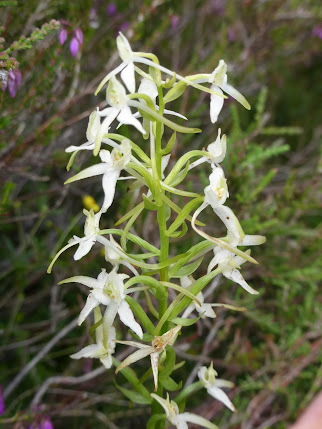16 members joined leader Geoff on one of the
hottest mornings of the year for this rather misnamed field meeting as, from
the car park, we immediately crossed the road to explore Fawley Inclosure.
 |
| Silver-studded Blues CR |
 |
| Grayling CR |
Within a few yards, all 3 heathers, Bell Heather, Cross-leaved Heath and Ling were attracting many Silver-studded Blue butterflies both
male and female and several mating pairs were spotted. Less numerous were
Gatekeeper, Grayling, Large White and Small Heath with a Silver Y moth, Golden-ringed Dragonfly and innumerable grasshoppers also seen.
Carrion Crows cruised
overhead and a Woodlark posed atop the gorse before flying off. Amongst the
heathers, Lousewort, Tormentil, Heath Milkwort, Self-heal and Coral-necklace
were identified.
 |
| Lady Fern DP |
Moving on, we passed the site of a scheduled
ancient monument known as a Bowl Barrow but were unable to pinpoint its exact
location. A Sparrowhawk flew above the trees and Goldfinches flitted around. As
we moved into the conifer plantation a Chaffinch was spotted. By this time
somewhat spread out, the botanists identified Sheep Sorrell, Wood Sage and Lady
Fern.
 |
| Oak Eggar moth (Lasiocampa quercus) CR |
Small Copper and Peacock
butterflies were seen as well as Riband Wave and Oak Eggar Moths with a Keeled
Skimmer dragonfly also posing obligingly.
Around the edge of an area of mire were some
good specimens of Round-leaved and Oblong-leaved Sundew along with Bog
Asphodel, White Beak-sedge, Cotton Grass and Pale Butterwort. Kestrel and
Buzzard were also spotted.
Cutting back through the plantation, we
risked life and limb on a brief detour across the busy A326 Fawley Road to
Forest Front Nature Reserve for the disabled. By the pond, much welcome shade
and seating provided an ideal location for an overdue refreshment break.
 |
| Nettle Weevil RC |
An
Emperor Dragonfly patrolled around the fine stand of Reedmace but although
movement could be seen, no birds or fish were identified. White Water-lily flowered in the pond and on
a short walk around the reserve a good variety of plants were evident, namely
Tufted Vetch, Rosebay Willowherb, Lesser Stitchwort, Common Knapweed, Hogweed,
Ladies’ Bedstraw and Corky-fruited Water Dropwort. Small Copper, Skipper and
Speckled Wood butterflies and a Blackcap were also seen. Richard collected a
small moth called Garden Grass Veneer (Chrysoteuchia
culmella) and Maureen picked up a striking
blue Nettle Weevil.
 |
| Small Red Damselflies CR |
Returning to the enclosure, we moved on to
Flash Pond where Coloured Water-lily flowered alongside Lesser Spearwort, Marsh
St. John’s Wort and Water-plantain. Blue damselflies hovered around and Small
Red amselflies were mating. |
| Meadow Pipit CR |
The return walk crossed open heathland where,
in the distance above the conifers, a Buzzard, two Kestrels and a Swift were
seen. Meadow Pipits and Stonechats, both adult and juvenile, were busy in the gorse and a Little
Egret was fishing in what remained of one of the larger ponds.
 |
| Lesser Water-plantain CR |
Some small
specimens of Lesser Water-plantain were clinging on in a dried-up puddle and we also
saw Chamomile in flower before crossing back to the car park.
GN
Photos: © Chris Robinson, Richard Coomber
 |
©Crown copyright 2021 Ordnance Survey. Media 008/21 |
GPX

















